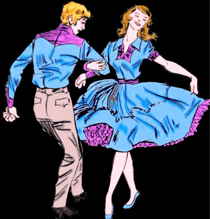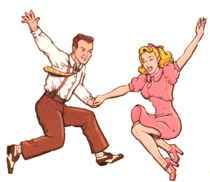
Arkansas Symbols
Arkansas State American Folk Dance
Square Dance

Adopted in 1991.
In 1991, the Arkansas General Assembly designated the square dance the official American folk dance of Arkansas. A concurrent resolution authored by Senator Jack Gibson of District 35 introduced the measure; it won quick approval and was signed into law by Governor Bill Clinton on February 7, 1991, as Act 93.
Square dancers perform a variety of steps, which are usually told to them by a person known as a square dance "caller."
Arkansas State American Folk Dance: Square Dance

The Arkansas State Square Dance Federation is the official organization of Arkansas Square Dancers. Within the ASSDF are five districts plus camper dancers: Northeast, Northwest, Southeast, and Central. Southwest District is inactive.
Square dance is a folk dance for four couples that was first described in 17th century England, but which has become associated with the United States of America due to its historic development in that country. The various movements used in square dancing are based on traditional folk dances of the various people who migrated to the USA. Some of these dances include Morris dance, English Country Dance, and the quadrille. Square dancing is enjoyed by people around the world, and people around the world are involved in the continuing development of this dance.
The movements are prompted by calls. The calls are put together by a caller to form a dance. The caller leads but does not participate in the dance.
There are two different types of square dance:
Traditional square dance, which is frequently presented in alternation with contra dances, and is most prevalent in New England, with Appalachia and the South being close seconds.
Western square dance, which is also called "modern Western square dance", "contemporary Western square dance", or "modern American square dance".
Western square dance is practiced worldwide.
Traditional and modern Western square dancing have a number of calls in common, but there are usually small differences in the way they are performed.
For example, the "Allemande Left" is traditionally performed by grasping left hands with the other dancer, leaning backwards slightly, and walking around a central axis. In Western dance the grip is modified so that each dancer grips the arm of the other, and there is less leaning. These modifications makes it easier to enter and exit the step, and thus easier to incorporate into a long sequence of calls.
Traditional square dance uses about 40 or 50 calls, and every dance is explained before you dance it. There is a list of some examples of traditional square dance steps at Contradance. Participants are made to feel welcome to make mistakes (within limits), and the mistakes can sometimes make the dance a lot more fun.
In Western square dance one dances a defined program where the participants have learned and become proficient in performing the steps necessary to dance the program. At the basic level this consists of 68 calls. When one dances Western square dance one is constantly challenged and surprised by the choreography of the caller. No two dances are ever alike!
A "call" means the name of a dance step, the phrase used by a caller to tell the dancers to dance it, and the dance step itself. It mirrors the ambiguity of the word "dance", which may mean a dance event, the dancing of an individual to the playing of one piece of music, or dancing in general.
A square dance call may take a very short time or a very long time to execute. In modern Western square dancing a call requires a specific number of counts to be executed, usually 4-32 counts. In traditional square dancing the timing of a call is fit to the music.
The music of the two forms also differs. In traditional square dance the music is traditional "country dance" music: Irish jigs and reels for the most part, as well as folk music from Quebec (Canada), England, Scotland, and other countries. The music is almost always performed live by a traditional dance music band. In Western square dance the music is a mixture of many types, everything from pop to traditional country to broadway musical to contemporary country music. The beat is also somewhat faster. The music is frequently played from recordings.
Another name for a traditional square dance is a quadrille. Quadrilles originated in upper-class England.
The Promenade Act (H. R. 645) is a bill before the United States Congress that proposes that Square Dance be designated as the national folk dance, and that arbitrarily defines certain related European-American dances as square dance.
In the Regular Session of the 78th General Assembly, Senator Gibson introduced Senate Bill No. 7, a bill to adopt the Square Dance as the official American Folk Dance of Arkansas.
State of Arkansas
78th General Assembly: A Bill
Regular Session, 1991: SENATE BILL 7
By: Senator Gibson
For An Act to Be Entitled
AN ACT TO DESIGNATE THE SQUARE DANCE AS THE AMERICAN FOLK DANCE OF THE STATE OF ARKANSAS.
WHEREAS, love of state and professions is enhanced by traditions that have become a part of our way of life and the customs of the American people;
and
WHEREAS, we have distinctive and meaningful symbols of our ideals in our state's flag and in many cultural endeavors, but no official designation of
a State Folk Dance; and
WHEREAS, the square dance, which was first associated with the American people and recorded in history since 1651, has consistently been the one dance
traditionally recognized by the American people as a dignified and enjoyable expression of American folk dancing; and
WHEREAS, square dancing is a traditional form of family recreation which symbolizes a basic strength of this country, namely the unity of family; and
WHEREAS, square dancing is an activity for young and old, where senior citizens enjoy dance and fellowship and where disabled persons become skilled,
happy and "handicapable" dancers; and
WHEREAS, square dancing is the American folk dance which is called, cued, or prompted to the dancers, and includes squares, rounds, clogging, contra,
line, and heritage dances; and
WHEREAS, official recognition of the square dance will enhance the cultural stature of Arkansas both nationally and internationally; and
WHEREAS, national and international prestige is the best interest of all Americans; and
WHEREAS, it is fitting that the square dance be added to the array of symbols of our state character and pride,
NOW THEREFORE,
BE IT ENACTED BY THE GENERAL ASSEMBLY OF THE STATE OF ARKANSAS:
SECTION 1. The dance known as the square dance is hereby designated and adopted as the American Folk Dance of the State of Arkansas.
SECTION 2. All provisions of this Act of a general and permanent nature are amendatory to the Arkansas Code of 1987 Annotated and the Arkansas Code
Revision Commission shall incorporate the same in the Code.
SECTION 3. If any provision of this Act or the application thereof to any person or circumstance is held invalid, such invalidity shall not affect
other provisions or applications of the Act which can be given effect without the invalid provision or application, and to this end the provisions
of this Act are declared to be severable.
SECTION 4. All laws and parts of laws in conflict with this Act are hereby repealed.
Arkansas Law
The law designating the square dance as the official Arkansas state folk dance is found in the Arkansas Code, Title 1, Chapter 4, Section 1-4-120.
TITLE 1. General Provisions.
CHAPTER 4. State Symbols, Motto, Etc.
SECTION 1-4-120. State folk dance.
1-4-120. State folk dance.
The dance known as the square dance is hereby designated and adopted as the American Folk Dance of the State of Arkansas.
History. Acts 1991, No. 93, § 1.







